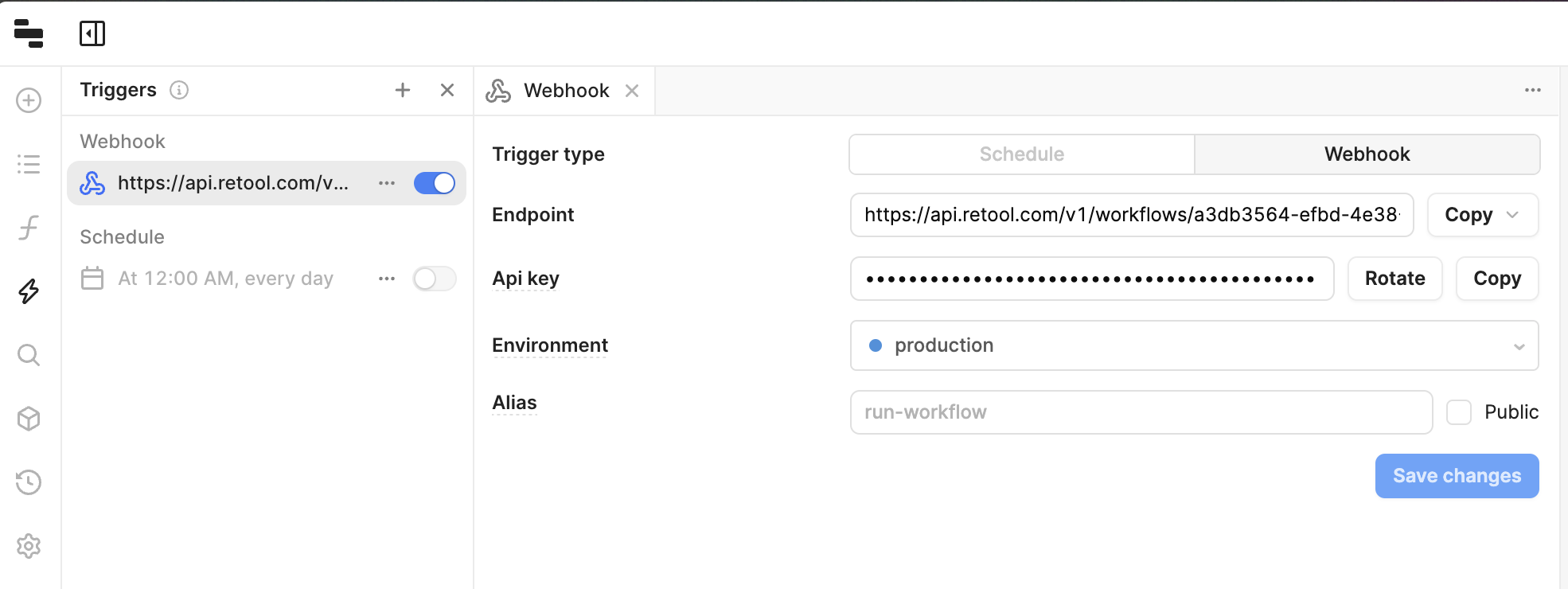Introduction
This page provides an instruction & guide for developers building a GPT Action for a specific application. Before you proceed, make sure to first familiarize yourself with the following information:
- Introduction to GPT Actions
- Introduction to GPT Actions Library
- Example of Building a GPT Action from Scratch
This particular GPT Action provides an overview of how to connect to a Retool Workflow. This Action takes a users input and sends it to the workflow in Retool using a webhook trigger. Retool then performns the configured workflow and sends a response back to ChatGPT as a JSON object.
Value + Example Business Use Cases
Value: Users can now leverage ChatGPT's natural language capability to connect directly to any workflow in Retool.
Example Use Cases:
- You have custom code running in a Retool workflow that you'd like to incorporate into a GPT.
- Data Scientists maintain an external VectorDB (either using Retool Vector or another vector DB) and would like to send the results of the vector search back to ChatGPT.
- Retool is used as middleware to connect to internal services, and you'd like to use Retool's webhooks to provide access to these services to ChatGPT.
Application Information
Application Key Links
Check out these links from the application before you get started:
- Application Website: https://retool.com/products/workflows
- Application API Documentation: https://docs.retool.com/workflows
Application Prerequisites
Before you get started, make sure you go through the following steps in your Retool environment:
- Set up a Retool account
- Create a simple workflow
Application Workflow Steps
Below is an example of a basic Retool Workflow. This workflow takes in 2 values and adds them and responds to the webhook trigger with the result.
Note: Your workflow must be deployed before it will be accessible from your GPT.
ChatGPT Steps
Custom GPT Instructions
Once you've created a Custom GPT, you should add Instructions to the GPT providing context about the GPTs role, and the actions it is able to perform. Have questions? Check out Getting Started Example to see how this step works in more detail.
OpenAPI Schema
Once you've created a Custom GPT, copy the text below in the Actions panel. Have questions? Check out Getting Started Example to see how this step works in more detail.
Note: You need to replace the <WORKFLOW_ID> value in the OpenAPI spec below with the ID for your workflow.
openapi: 3.1.0
info:
title: Retool Workflow API
description: API for interacting with Retool workflows.
version: 1.0.0
servers:
- url: https://api.retool.com/v1
description: Main (production) server
paths:
/workflows/<WORKFLOW_ID>/startTrigger:
post:
operationId: add_numbers
summary: Takes 2 numbers and adds them.
description: Initiates a workflow in Retool by triggering a specific workflow ID.
requestBody:
required: true
content:
application/json:
schema:
type: object
properties:
first:
type: integer
description: First parameter for the workflow.
second:
type: integer
description: Second parameter for the workflow.
responses:
"200":
description: Workflow triggered successfully.
"400":
description: Bad Request - Invalid parameters or missing data.
"401":
description: Unauthorized - Invalid or missing API key.
security:
- apiKeyAuth: []Authentication Instructions
Below are instructions on setting up authentication with this 3rd party application. Have questions? Check out Getting Started Example to see how this step works in more detail.
Pre-Action Steps
Before you set up authentication in ChatGPT, please take the following steps in the application.
- Get your API Key from the Webhook config panel

In ChatGPT
In ChatGPT, click on "Authentication" and choose "API Key". Enter in the information below.
- API Key: (Paste your API Key provided by the Retool Workflow Webhook Trigger)
- Auth Type: Custom
- Custom Header Name: X-Workflow-Api-Key
FAQ & Troubleshooting
- Auth Error: Ensure you have set the custom header name correctly.
- Invalid Workflow Error: Ensure you have deployed your workflow within Retool.
Are there integrations that you’d like us to prioritize? Are there errors in our integrations? File a PR or issue in our github, and we’ll take a look.
